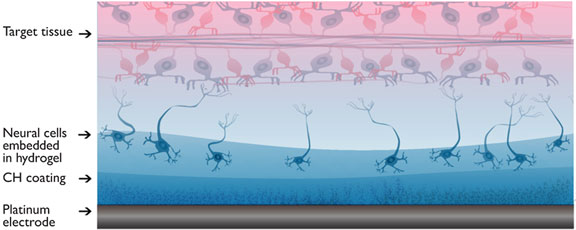Crossref Citations
This article has been cited by the following publications. This list is generated based on data provided by
Crossref.
Barriga-Rivera, Alejandro
Bareket, Lilach
Goding, Josef
Aregueta-Robles, Ulises A.
and
Suaning, Gregg J.
2017.
Visual Prosthesis: Interfacing Stimulating Electrodes with Retinal Neurons to Restore Vision.
Frontiers in Neuroscience,
Vol. 11,
Issue. ,
Lim, Khoon S
Levato, Riccardo
Costa, Pedro F
Castilho, Miguel D
Alcala-Orozco, Cesar R
van Dorenmalen, Kim M A
Melchels, Ferry P W
Gawlitta, Debby
Hooper, Gary J
Malda, Jos
and
Woodfield, Tim B F
2018.
Bio-resin for high resolution lithography-based biofabrication of complex cell-laden constructs.
Biofabrication,
Vol. 10,
Issue. 3,
p.
034101.
Weigel, Tobias
Schmitz, Tobias
Pfister, Tobias
Gaetzner, Sabine
Jannasch, Maren
Al-Hijailan, Reem
Schürlein, Sebastian
Suliman, Salwa
Mustafa, Kamal
and
Hansmann, Jan
2018.
A three-dimensional hybrid pacemaker electrode seamlessly integrates into engineered, functional human cardiac tissue in vitro.
Scientific Reports,
Vol. 8,
Issue. 1,
Shoffstall, Andrew J.
and
Capadona, Jeffrey R.
2018.
Bioinspired materials and systems for neural interfacing.
Current Opinion in Biomedical Engineering,
Vol. 6,
Issue. ,
p.
110.
Feron, Krishna
Lim, Rebecca
Sherwood, Connor
Keynes, Angela
Brichta, Alan
and
Dastoor, Paul C.
2018.
Organic Bioelectronics: Materials and Biocompatibility.
International Journal of Molecular Sciences,
Vol. 19,
Issue. 8,
p.
2382.
Pas, Jolien
Rutz, Alexandra L
Quilichini, Pascale P
Slézia, Andrea
Ghestem, Antoine
Kaszas, Attila
Donahue, Mary J
Curto, Vincenzo F
O’Connor, Rodney P
Bernard, Christophe
Williamson, Adam
and
Malliaras, George G
2018.
A bilayered PVA/PLGA-bioresorbable shuttle to improve the implantation of flexible neural probes.
Journal of Neural Engineering,
Vol. 15,
Issue. 6,
p.
065001.
Green, Rylie
2018.
Are ‘Next Generation’ Bioelectronics Being Designed Using Old Technologies?.
Bioelectronics in Medicine,
Vol. 1,
Issue. 3,
p.
171.
Aregueta‐Robles, Ulises A.
Martens, Penny J.
Poole‐Warren, Laura A.
and
Green, Rylie A.
2018.
Tailoring 3D hydrogel systems for neuronal encapsulation in living electrodes.
Journal of Polymer Science Part B: Polymer Physics,
Vol. 56,
Issue. 4,
p.
273.
Goding, Josef
Vallejo-Giraldo, Catalina
Syed, Omaer
and
Green, Rylie
2019.
Considerations for hydrogel applications to neural bioelectronics.
Journal of Materials Chemistry B,
Vol. 7,
Issue. 10,
p.
1625.
Dalrymple, Ashley N
Huynh, Mario
Robles, Ulises Aregueta
Marroquin, Jason B
Lee, Curtis D
Petrossians, Artin
Whalen, John J
Li, Dan
Parkington, Helena C
Forsythe, John S
Green, Rylie A
Poole-Warren, Laura A
Shepherd, Robert K
and
Fallon, James B
2019.
Electrochemical and mechanical performance of reduced graphene oxide, conductive hydrogel, and electrodeposited Pt–Ir coated electrodes: an activein vitrostudy.
Journal of Neural Engineering,
Vol. 17,
Issue. 1,
p.
016015.
Aregueta-Robles, Ulises A.
Martens, Penny J.
Poole-Warren, Laura A.
and
Green, Rylie A.
2019.
Tissue engineered hydrogels supporting 3D neural networks.
Acta Biomaterialia,
Vol. 95,
Issue. ,
p.
269.
Akbar, Teuku Fawzul
Tondera, Christoph
and
Minev, Ivan
2020.
Neural Interface Engineering.
p.
237.
Guido, Katrina
Clavijo, Ana
Zhu, Keren
Ding, Xinqian
and
Ma, Kaimin
2020.
Neural Interface Engineering.
p.
173.
Lee, Seunghyeon
Ozlu, Busra
Eom, Taesik
Martin, David C.
and
Shim, Bong Sup
2020.
Electrically conducting polymers for bio-interfacing electronics: From neural and cardiac interfaces to bone and artificial tissue biomaterials.
Biosensors and Bioelectronics,
Vol. 170,
Issue. ,
p.
112620.
Vallejo-Giraldo, Catalina
Genta, Martina
Cauvi, Olivia
Goding, Josef
and
Green, Rylie
2020.
Hydrogels for 3D Neural Tissue Models: Understanding Cell-Material Interactions at a Molecular Level.
Frontiers in Bioengineering and Biotechnology,
Vol. 8,
Issue. ,
Yang, Jia-Wei
Yu, Zih-Yu
Cheng, Sheng-Jen
Chung, Johnson H. Y.
Liu, Xiao
Wu, Chung-Yu
Lin, Shien-Fong
and
Chen, Guan-Yu
2020.
Graphene Oxide–Based Nanomaterials: An Insight into Retinal Prosthesis.
International Journal of Molecular Sciences,
Vol. 21,
Issue. 8,
p.
2957.
Shoffstall, Andrew J.
and
Capadona, Jeffrey R.
2020.
Biomaterials Science.
p.
1153.
Dalrymple, Ashley N
Robles, Ulises A
Huynh, Mario
Nayagam, Bryony A
Green, Rylie A
Poole-Warren, Laura A
Fallon, James B
and
Shepherd, Robert K
2020.
Electrochemical and biological performance of chronically stimulated conductive hydrogel electrodes.
Journal of Neural Engineering,
Vol. 17,
Issue. 2,
p.
026018.
Zerdoum, Aidan B.
Saberi, Pooya
Stuffer, Alexander J.
Kelly, Dakota J.
Duncan, Randall L.
Mongeau, Luc
and
Jia, Xinqiao
2020.
Regulation of Stem Cell Function in an Engineered Vocal Fold-Mimetic Environment.
Regenerative Engineering and Translational Medicine,
Vol. 6,
Issue. 2,
p.
164.
Rochford, Amy E.
Carnicer‐Lombarte, Alejandro
Curto, Vincenzo F.
Malliaras, George G.
and
Barone, Damiano G.
2020.
When Bio Meets Technology: Biohybrid Neural Interfaces.
Advanced Materials,
Vol. 32,
Issue. 15,
